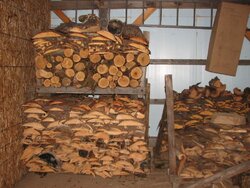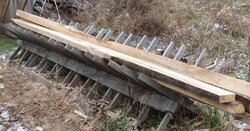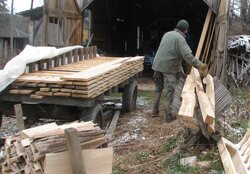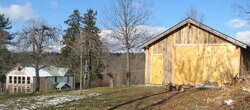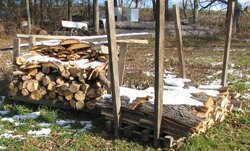I know I have seen a comment about this in another thread, but I can not remember which one it was. Seems to me I remember someone in the boiler room saying that he does not, and you should not, put cold wood into your boiler/furnace. I tend to have a two or three day supply of wood in my basement, and rotate it as I bring it in. So the wood going into the wood boiler is at room temperature. My basement is always between 70-75 degrees. Even if the M.C. of our wood is at say 20%, there is moisture there. If it is 15 degrees outside, then that moisture is frozen. Does everyone keep the wood going into the boiler inside for a pre warm up? What do you guys do? And what do you think about this?
Does it matter what the temperature of your wood is going into your boiler/furnace?
- Thread starter Gasifier
- Start date
-
Active since 1995, Hearth.com is THE place on the internet for free information and advice about wood stoves, pellet stoves and other energy saving equipment.
We strive to provide opinions, articles, discussions and history related to Hearth Products and in a more general sense, energy issues.
We promote the EFFICIENT, RESPONSIBLE, CLEAN and SAFE use of all fuels, whether renewable or fossil.
You are using an out of date browser. It may not display this or other websites correctly.
You should upgrade or use an alternative browser.
You should upgrade or use an alternative browser.
- Status
- Not open for further replies.
N
nate379
Guest
I keep a couple day supply of wood near my stove for the simple fact that I don't have to go outside in the cold and haul in an arm load or two of wood everyday.
I find that it does catch on fire a little bit better when it's thawed out, but it's not like it takes long to do that when it's in the stove anyhow.
I find that it does catch on fire a little bit better when it's thawed out, but it's not like it takes long to do that when it's in the stove anyhow.
afblue
Feeling the Heat
Its about 10-15 feet from my wood storage in the basement to the boiler because its stored in the corner on the other side of my huge 830gal unpressurized tank. So I have a old bank cart that I can fit about 1/3 face cord on, so I load it up and park it in front of the boiler so the heat from the doors, helps dry it out as much as it can before it goes in the boiler. Not really sure if it helps but I can do it with great convience so why not.
woodsmaster
Minister of Fire
I keep a couple weeks worth in the boiler shed. When I bring the wood in the shed it is allready at 18% in the middle,
But you can still feal moisture and smell it for a couple days afterwards. It does burn better after being in there a couple days.
But you can still feal moisture and smell it for a couple days afterwards. It does burn better after being in there a couple days.
wood thing
Member
I have two 500 gal horiz storage tanks with a space inbetween. The tanks are insul and enclosed in a 2x4, plwood box. I have wood racks on top of these. I don't have to bend over and what heat leakage there is from the tanks help dry and warm the wood. I keep about a weeks worth ahead. It works great for me.
I have to believe it makes some difference. It takes energy to change the state of water. Wood that is moved from outside to the basement has time to thaw any moisture that is in it and even loose some MC befroe going into your boiler. Wood that comes direclty inside then into the boiler would have to be warmed so that any moisture melts (takes energy which isn't warming your boiler) and then you boil off the MC (more energy).
Someone smart then me I am msure gould quantify this, not sure if it a huge amount of energy lost. When I first started burning wood in a wood stove O learned pretty quick that bring in wood and burnning it didn't seem to put out as much heat as storing 3 weeks worth of wood and at the end of the week replacing what I burned. Now with the boiler I have 4-5 weeks worth inside and still replce what was burned weekly.
Someone smart then me I am msure gould quantify this, not sure if it a huge amount of energy lost. When I first started burning wood in a wood stove O learned pretty quick that bring in wood and burnning it didn't seem to put out as much heat as storing 3 weeks worth of wood and at the end of the week replacing what I burned. Now with the boiler I have 4-5 weeks worth inside and still replce what was burned weekly.
maple1
Minister of Fire
All my wood is in my basement all winter.
More space down there year round would be nice - but not as nice as not having to go outside all winter to fire the furnace.
That might not have helped the discussion much...
More space down there year round would be nice - but not as nice as not having to go outside all winter to fire the furnace.
That might not have helped the discussion much...
I
ISeeDeadBTUs
Guest
maple1 said:nice as not having to go outside all winter to fire the furnace.
That might not have helped the discussion much...
Helped make some of us jealous, no doubt ;-)
My 'boiler room' is a shed ~60' from the garage door. It will hold ~ 1 cord of wood, though when full there isnot much room around the boiler especially on one side. Depending on my health and those two four letter words - work and life - I don't always keep the shed full. And since I let make-up air come into the shed freely, it's not THAT warm in there anyway. The two BIG advantages to storing wood in the boiler room seem to be:
1) Keeps snow/rain from turning into ice on the outside of the wood. Let me assure you, THAT makes for a very bad fire, BTDT :shut:
2) On the rare occasions thatthe Mrs has to tend the boiler, the wood is right there in the room.
But technically, does wood NEED to be warm to ignite? No idea.
FWIW, around here, many OWB guys have gone to those $1,000 aluminum canopies covering the boiler and their wood.
Someone smart then me I am msure gould quantify this, not sure if it a huge amount of energy lost. When I first started burning wood in a wood stove O learned pretty quick that bring in wood and burnning it didn’t seem to put out as much heat as storing 3 weeks worth of wood and at the end of the week replacing what I burned. Now with the boiler I have 4-5 weeks worth inside and still replce what was burned weekly.
I agree with that Timberr. The beginning of the very first season heating with my P.E. Super 27 I noticed that as well. That was when I started bringing in enough wood for 2-3 days and rotating it as I burned. So, of course, I continued doing the same thing with the Wood Gun. I do have to get my butt in gear and build a new wood rack. I want to build one that will have two levels, maybe three, for different size splits. :cheese:
Do any of you remember someone commenting fairly recently on how he does not put cold wood into his boiler, and that it should not be done? Seems like he said it would create or cause some problem with your boiler. Condensation, oxidation? Any truth to it hurting your boiler or furnace?
The only problem with searching for it is, :lol: , is when you put in the words cold, wood, and boiler, you come up with a lot of threads! :lol:
I agree with that Timberr. The beginning of the very first season heating with my P.E. Super 27 I noticed that as well. That was when I started bringing in enough wood for 2-3 days and rotating it as I burned. So, of course, I continued doing the same thing with the Wood Gun. I do have to get my butt in gear and build a new wood rack. I want to build one that will have two levels, maybe three, for different size splits. :cheese:
Do any of you remember someone commenting fairly recently on how he does not put cold wood into his boiler, and that it should not be done? Seems like he said it would create or cause some problem with your boiler. Condensation, oxidation? Any truth to it hurting your boiler or furnace?
The only problem with searching for it is, :lol: , is when you put in the words cold, wood, and boiler, you come up with a lot of threads! :lol:
I
ISeeDeadBTUs
Guest
Yo, Gassi ... I think it was the guy from the left coast with the two 'Jetsteams'. IIRC his thinking was that the cold mass of wood coming in contact with the refractory makes for a dramatic temp swing in one location of the refractory, which will eventually cause the fefractory to crack.
I tend to agree with him on that, assuming I am paraphrasing him correctly - heaven forbid I do it wrong and pizz off one mod - in that the GW's all seem to crack within a short time. For those of us that burn 24/7 during the season, there shouldn't be much temp swing in the refractory except for the cold wood coming in contact with the refractory.
I try to NOT have the ends of my wood touch the sides of my refractory. 'Course, it's too late now since my combustion chamber is cracked about as much as Humpty Dumpty on methamphetemine.
I tend to agree with him on that, assuming I am paraphrasing him correctly - heaven forbid I do it wrong and pizz off one mod - in that the GW's all seem to crack within a short time. For those of us that burn 24/7 during the season, there shouldn't be much temp swing in the refractory except for the cold wood coming in contact with the refractory.
I try to NOT have the ends of my wood touch the sides of my refractory. 'Course, it's too late now since my combustion chamber is cracked about as much as Humpty Dumpty on methamphetemine.
Retired Engineer
Member
I find that I like loading my garn with wood that is dry and warm much better than feeding the old smoke dragon with wet cold wood from outside. It works much better also, and uses much less wood. I can store lots of wood in the garn barn and open the door between the storage and loading room to keep the storage room from freezing. Slabs come directly from the sawmill to a cutting rack, then to a pallet, moved to a drying area, then into the storage area.
When finally finished insulating and installing a water to air exchanger the storage area will be used to dry lumber.
When finally finished insulating and installing a water to air exchanger the storage area will be used to dry lumber.
Attachments
infinitymike
Minister of Fire
bioman
Feeling the Heat
I like it as warm as possible, i keep 4 cords right next to the boiler. i only burn every other day, so after the fire is done i can load the next burn and it will be ready for the next burn cycle. I think it helps, i have in the past brought in wood from outside with snowy conditions and thought it was not the best practice. I know it sounds wastefull, but i light my fire with a propane torch, about 30 seconds and it's going good, but my wood is also the same temp as the boiler. works for me.
bioman
Feeling the Heat
Hunderliggur
Minister of Fire
It takes one BTU to raise one pound of water one degree F
It takes 144 BTUs to melt one pound of ice
It takes 970 BTUs to turn one pound of water to steam
So....
Unfrozen wood is better than frozen wood
Dry wood is better than wet (but we all know that, don't we?)
It takes 144 BTUs to melt one pound of ice
It takes 970 BTUs to turn one pound of water to steam
So....
Unfrozen wood is better than frozen wood
Dry wood is better than wet (but we all know that, don't we?)
infinitymike
Minister of Fire
infinitymike
Minister of Fire
Hunderliggur said:It takes one BTU to raise one pound of water one degree F
It takes 144 BTUs to melt one pound of ice
It takes 970 BTUs to turn one pound of water to steam
So....
Unfrozen wood is better than frozen wood
Dry wood is better than wet (but we all know that, don't we?)
I love this place!! I never stop learning.
I
ISeeDeadBTUs
Guest
Hunderliggur said:It takes one BTU to raise one pound of water one degree F
It takes 144 BTUs to melt one pound of ice
It takes 970 BTUs to turn one pound of water to steam
I need clarification . . .
Wouldn't it depend on how cold the ice was?
and similarly
Wouldn't it depend on how hot the water was?
Clarkbug
Minister of Fire
ISeeDeadBTUs said:Hunderliggur said:It takes one BTU to raise one pound of water one degree F
It takes 144 BTUs to melt one pound of ice
It takes 970 BTUs to turn one pound of water to steam
I need clarification . . .
Wouldn't it depend on how cold the ice was?
and similarly
Wouldn't it depend on how hot the water was?
Nope!
Ice is 32 degrees F when it is at a change of state. So the solid part and the liquid part are both 32 (or at least close enough for our discussion today) So those 144 BTUS just change the ice from solid to liquid, and no additional temperature change happens.
Same thing with liquid to gas. The liquid and gas are both at 212F at that instant of phase change. All of those BTUs go into making the liquid a gas. (This is part of the reason a steam burn hurts so much, it gives you all of that energy at once when it condenses on your skin)
ISeeDeadBTUs said:Yo, Gassi ... I think it was the guy from the left coast with the two 'Jetsteams'. IIRC his thinking was that the cold mass of wood coming in contact with the refractory makes for a dramatic temp swing in one location of the refractory, which will eventually cause the fefractory to crack. I tend to agree with him on that, assuming I am paraphrasing him correctly - heaven forbid I do it wrong and pizz off one mod - in that the GW's all seem to crack within a short time. For those of us that burn 24/7 during the season, there shouldn't be much temp swing in the refractory except for the cold wood coming in contact with the refractory. I try to NOT have the ends of my wood touch the sides of my refractory. 'Course, it's too late now since my combustion chamber is cracked about as much as Humpty Dumpty on methamphetemine.
You may be right ISDBTUs. Thanks for your input. Seems as if there was one comment on the moisture possibly creating a problem in the boiler and for some reason I thought it would be related to the metal of the hull. Maybe eventually the person who talked about that before will see this and respond. I burn 24/7 after it starts getting cold enough. Before that I can burn once, or twice a day, and just keep the buffer tank hot enough to meet the DHW and low heat demand of the house. How long have you been burning in your GW?
Dry wood is better than wet (but we all know that, don’t we?)
:lol: I think most of us do know this. At least I hope. But even "dry" wood has some moisture in it. And I thought the discussion of the temperature of your wood going into your boiler would be interesting. Even with 18-20% moisture content wood, which is good, there is that moisture in it that will be frozen. And I think there are probably a lot of times when some peoples wood may be a little higher in moisture content do to the fact that they have not had the time to get their wood dry. I have heard that it may not be good for your bioler/furnace to be putting that really cold wood in it. I thought it would be worth discussing.
Now, I have heard about a lot of the old outdoor wood boilers, what are commonly referred to as "smoke dragons", rusting through. Could some of that have been caused by putting all their freezing wood in a hot boiler? There are a lot of outdoor wood boilers around here, and almost all have there wood outside. One of the selling points is not having the mess of the wood inside. A lot of times the wood is not even covered by a roof. And according to some of the burners of these boilers, you don't need to season the wood. Now I don't want this to turn into a discussion and bashing of OWB.
Just discussing the idea of cold wood or warm wood being better to burn in the boiler/furnace or wood stove. Anyone know if it could actually hurt the steel hull of the boiler, forced air wood furnace or wood stove?
woodywoodchucker
New Member
Man I love this site. I plan on building a shed around my 5036 and being able to store 6 cord inside with the boiler.I cant help but to believe that the heat from the boiler my pre heat the wood just a bit and also season it as well. Im thinking that the wood will act as an insulator.That boiler is at 180* and must throw some heat.My plan is to build a shed so I can stack 3 cord of wood on each side of the boiler.Burn and refill one side at a time.
ewdudley
Minister of Fire
woodywoodchucker said:I cant help but to believe that the heat from the boiler my pre heat the wood just a bit and also season it as well. Im thinking that the wood will act as an insulator.That boiler is at 180* and must throw some heat.My plan is to build a shed so I can stack 3 cord of wood on each side of the boiler.Burn and refill one side at a time.
Since you're building from scratch, I would suggest some radiant heat under the wood pile. I've been heating the floor under a wood pile for a few weeks now and it's been working very well for some 35% wood I'll be needing early this spring.
I've just been running the under-wood-pile heat with a wind-up timer a couple hours at a time a couple times a week and seems to drive the cold damp air out from under the pile, and the wood is drying down very nicely.
So it's working great for half-dried wood with winter air, I kind of doubt it would be a good idea to try it with green wood straight into heated-floor storage. But I'm going to try it with a cord or two next summer anyway, it would be great to be able to go from splitter to boiler room storage without a move and restack operation.
--ewd
TCaldwell
Minister of Fire
aside from the moisture aspect of cold wood, just the addition the cold mass, say 5-8 splits on a reload could weigh 15-20+lbs. That has the ability to lower the firebox temp for a extended period delaying gasification. I have a type k in the secondary burn chamber of the garn, keep your wood inside if possible.
DaBackBurner
Member
ewdudley said:woodywoodchucker said:I cant help but to believe that the heat from the boiler my pre heat the wood just a bit and also season it as well. Im thinking that the wood will act as an insulator.That boiler is at 180* and must throw some heat.My plan is to build a shed so I can stack 3 cord of wood on each side of the boiler.Burn and refill one side at a time.
Since you're building from scratch, I would suggest some radiant heat under the wood pile. I've been heating the floor under a wood pile for a few weeks now and it's been working very well for some 35% wood I'll be needing early this spring.
I've just been running the under-wood-pile heat with a wind-up timer a couple hours at a time a couple times a week and seems to drive the cold damp air out from under the pile, and the wood is drying down very nicely.
So it's working great for half-dried wood with winter air, I kind of doubt it would be a good idea to try it with green wood straight into heated-floor storage. But I'm going to try it with a cord or two next summer anyway, it would be great to be able to go from splitter to boiler room storage without a move and restack operation.
--ewd
+1
It's been working great for me as well. I was behind (catching up now) last year. Split my wetter wood smaller for more surface area, built some racks over my slab radiant, put a fan on for more convection, and watched the wood slowly 'popcorn'. Loved it so much I brought the whole 10 cord into the garage to try and get ahead. This year and from now on I store 4 cord in there. One rack gets empty I refill it as another rack is being used. It's amazing the difference between dry warm wood, vs wet frozen wood.
- Status
- Not open for further replies.
Similar threads
- Replies
- 20
- Views
- 846
- Replies
- 4
- Views
- 478
- Replies
- 1
- Views
- 597
- Replies
- 4
- Views
- 1K


